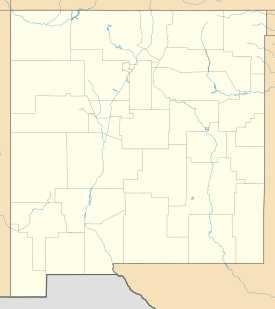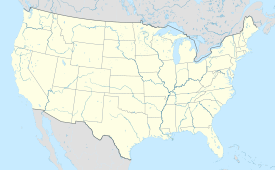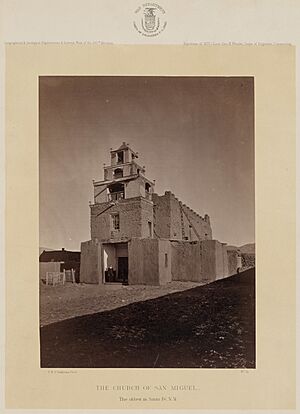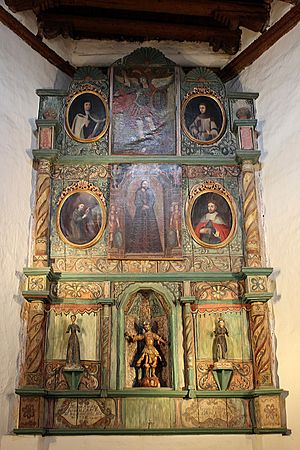San Miguel Mission facts for kids
Quick facts for kids San Miguel Archángel |
|
|---|---|
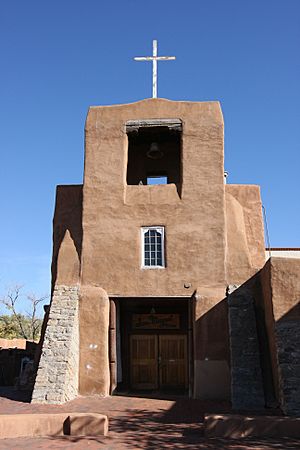
The front exterior to the Chapel of San Miguel
|
|
| Religion | |
| Affiliation | Roman Catholic |
| Status | Active |
| Location | |
| Location | Santa Fe, New Mexico, U.S. |
| Architecture | |
| Architectural type | Adobe construction in the Romanesque fortress church style, with heavily buttressed walls and battlements on the flat roof. |
| Architectural style | Spanish |
| Completed | c. 1610 |
| U.S. National Historic Landmark | |
| Added to NRHP | November 24, 1968 |
| NRHP Reference no. | 68000032 |
| Designated as NHL | November 24, 1968 |
The San Miguel Chapel is a historic mission church located in Santa Fe, New Mexico. It was first built around 1610. Many people believe it is the oldest church building in the United States.
The church was rebuilt two times. The first time was in the mid to late 1600s. The second time was in 1710, after the Pueblo Revolt. Parts of the older building might have been used again. A large wooden screen behind the altar, called a reredos, was added in 1798. This screen includes a wooden statue of Saint Michael that has been there since at least 1709.
San Miguel Chapel is part of the Barrio De Analco Historic District. This district is a special place recognized as a U.S. National Historic Landmark. As of 2020, church services (called Mass) are still held at the chapel. They happen on the first Sunday of each month at 3 PM.
Contents
History of the Chapel
The first San Miguel church was likely built soon after Santa Fe was founded in 1610. It was the very first church in this new Spanish settlement. It was built across the Santa Fe River. This area was called the Barrio de Analco. Native people, including some Tlaxcalans who came with the Spanish from Mexico, mostly lived there.
The Spanish wanted to teach Christianity to the native people. So, they built this church for them first. They built it before their own main church, called a Parroquia, near the town square. In 1630, a leader named Alonso de Benavides wrote about the church. He said the church they had was just a poor hut. He explained that the priests focused on building churches for the Native Americans first. When he became the leader, he started to build a proper church.
The San Miguel Chapel was first mentioned in official writings in 1628. This shows it was already being used then. The first chapel was probably smaller than it is today. It had a simple rectangular back section (called an apse). It also had a slightly raised area for the altar (a sanctuary). The front was plain, without towers. Old foundations of the church were studied in 1955.
In 1640, there was a big disagreement between Governor Luis de Rosas and the Franciscan missionaries. The Franciscans were priests who ran the church in New Mexico. This conflict led to all the Franciscans being forced out of Santa Fe. The mission church was partly or completely taken apart. Later, Governor De Rosas was put in jail. The Franciscans were able to come back and rebuild the mission.
The church was damaged again in 1680 during the Pueblo Revolt. This was a major uprising where the Pueblo people worked together. They wanted to force the Spanish out of New Mexico.
Rebuilding and Changes
When Diego de Vargas led the Spanish back into Santa Fe in 1692, he found the mission burned. But it could be fixed. In his report from December 18, 1693, he said the church was small. He noted it was not big enough for many people. But because of the bad weather, they needed a church quickly. He ordered the native people to help fix the walls and roof. He also said the Spanish people would help.
A more complete rebuilding happened in 1710. This work was led by Don Agustín Flores Vergara. His name is on the main wooden beam that holds up the choir loft. The governor at that time, the Marquis de la Peñuela, is also named there. The church was likely rebuilt on the same foundations. It had a similar layout to the earlier building. However, the back section (apse) was changed from rectangular to a trapezoid shape.
In 1776, a priest named Fray Atanasio Domínguez visited San Miguel. He wrote a detailed description of the church. He noted it was made of adobe bricks. The walls were not very thick. It had one main room (a nave). The ceiling had round wooden beams. There was a choir loft over the main door. He also mentioned three windows and a simple door.
Sometime after Domínguez's visit, perhaps in the 1830s, the current bell tower was added to the front. By 1846, when the Americans took control, church services were held only twice a year. The top parts of the tower fell down during a storm in 1872. By the 1880s, the whole building was in poor condition.
In 1881, the Archdiocese of Santa Fe sold the church. It was bought by the Christian Brothers. They ran the nearby St. Michael's College. Under their care, the church was repaired in 1887. The bell tower was rebuilt. Stone supports (called buttresses) were added to make the walls stronger. This repair made the building look more European. It added arched openings and a sloped metal roof to the front. These additions were later removed in 1955 during the most recent renovation.
Chapel Architecture
San Miguel Mission is built from adobe bricks. It has one main rectangular room (a nave) and a trapezoid-shaped back section (an apse). The walls are about 5 feet (1.5 meters) thick. The inside of the church is about 24 feet (7.3 meters) wide. It is 70 feet (21 meters) long and 25 feet (7.6 meters) high.
The ceiling is held up by large wooden beams called vigas. Two of these vigas are square and are thought to be from 1710. The other vigas are round and are newer replacements. Light comes into the church from a high window in the south wall. There is also a special opening above the sanctuary called a clerestory.
The choir loft is supported by a strong, carved beam. This beam stretches across the width of the nave. It holds up 13 other carved beams. The main beam has an inscription that says:
|
El Señor Marquez de la Peñuela hizo esta fabrica |
The Marquis de la Peñuela built this building |
The front of the church faces west. It has a central bell tower with one small window. There is a larger open space right above the main entrance. Five stone supports (buttresses) help hold up the building. These were added in 1887. Two are on the front, and three are on the north side. To the south of the main room are a sacristy (a room where priests prepare), a robing room, and other storage and living areas.
The Reredos (Altar Screen)
The wooden screen behind the altar, called a reredos, was made in 1798. It is believed to be the work of an artist known as the "Laguna Santero." This artist was active in New Mexico between 1796 and 1808.
The screen has large, twisted columns on its sides, known as Solomonic columns. In the middle of the reredos is a special carved space (a niche). This niche has its own small columns. Inside it is a wooden statue of St. Michael the Archangel holding a sword. This statue came from Mexico in 1709. It has been in the church since at least 1776.
Right above the statue is a large painting of Jesus from the mid-1700s. This painting was found behind the altar screen during the 1955 renovations. At the very top center is a painting of St. Michael from 1745. It is thought to be by Bernardo de Miera y Pacheco.
Around these two paintings are four oval oil paintings on canvas. These paintings are from Mexico and date to the early 1700s. Starting from the top left and going clockwise, they show St. Teresa of Ávila, St. Gertrude, St. Louis, and St. Francis of Assisi. The entire reredos was painted over at one point but was later cleaned and restored.
On each side of the reredos are two paintings. They show the Annunciation, which is when the Angel Gabriel told Mary she would have Jesus. These paintings are thought to be by one of the students of Bartolomé Esteban Murillo, a famous Spanish painter. In the early 1900s, these paintings were wrongly said to be by Cimabue and from 1287.
The San Miguel Bell
Another interesting item at the church is the bell. This bell hung in the bell tower before 1872. It is now on display inside the building. The bell is mostly made of copper. It weighs about 780 pounds (354 kg). It has an inscription that says:
|
San José ruega por nosotros |
Saint Joseph pray for us |
The date 1356 on the bell caught the attention of historians and the public. People claimed the San Miguel bell, along with a similar bell dated 1355, were the oldest bells in the United States. However, this idea was proven wrong in 1914 by Benjamin Read. He found an old man who remembered the bell being made in Santa Fe. The man confirmed the correct date was 1856, not 1356.
Also, the bell does not look like real church bells from the 1300s. Those bells would have had Latin writing and Roman numerals for dates. It was also very unlikely that two such large and heavy bells would have been brought from Europe. Bells could be made locally. It is believed that a mistake during the casting process made the number 8 look like a 3.
See also
 In Spanish: Misión de San Miguel (Santa Fe) para niños
In Spanish: Misión de San Miguel (Santa Fe) para niños
- List of churches in the Roman Catholic Archdiocese of Santa Fe
- Oldest buildings in the United States
- Oldest churches in the United States
- Camino Real de Tierra Adentro


